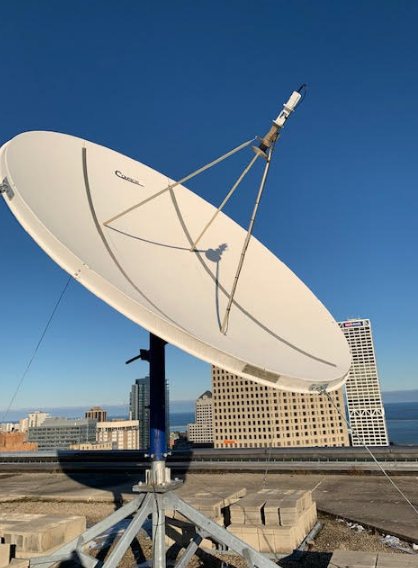Corrugated horn antennas outperform conventional ones due to enhanced mode conversion, lower side and back lobes by up to 30 dB, superior polarization purity, wider bandwidth by 10-15%, and improved beam symmetry and reduced cross-polarization by over 10 dB.
Mode Conversion and Propagation
Corrugated horn antennas outperform general horn antennas by better handling mode conversion and propagation. These horns are established on the internal surface with a periodic corrugation that alters electromagnetic wave propagation within the horn. This structural adjustment is essential for conversion of the basic transverse electric and transverse magnetic modes into a hybrid HE11 mode which possesses both a uniform phase front and amplitude distribution across the antenna’s aperture. The HE11 mode is critical for achieving high efficiency. It ensures that the electromagnetic energy is focused more directly and with reduced dispersion, thus providing adequate gain.
Generally speaking, corrugated horns can improve gain by up to 3 dB compared to general horns in the same operating conditions. This improvement results in a gain pattern enabling a more focused and powerful beam, which is essential for long-distance communications when the signal’s strength and integrity are critically important. Furthermore, since the gain is not wasted on generating sidelobes, the signal is not weakened or dissipated in unintended directions, which means that the signal will be cleaner at longer distances. At a satellite communication system, a corrugated horn antenna will be able to carry a properly clear signal even at a longer distance used for maintaining a contact between the satellites and the ground station or between two space vehicles.
In addition, another positive outcome of the present structural design and the follow-up mode conversion, the antennas do not cause any impedance mismatching, which implies that their frequency range can also be extended. This is important for a radar system, satellite communication system, or any other broadcast system because it broadens the range of operations and frequencies.

Low Side Lobes and Back Lobes
In both radio astronomy and radar systems, corrugated horn antennas exhibit a distinct advantage over their conventional counterparts in terms of side and back lobe intensities. In particular, one of the key benefits of the corrugated horns is that they exhibit a significantly lower intensity for the side lobes and back lobes compared to the conventional horns. The advantage of lower side lobes is particularly of great importance in practical applications such as radar systems and astronomical observatories. Low side lobes are instrumental in the application of radar systems such as air traffic control in which the low side lobes ensure the low interference of unwanted directions.
In other words, an antenna meant for air traffic control must exhibit low side lobes so that signals from unwanted directions are completely ignored, and signals from the desired aircraft that are meant to be detected for their position identification are not intercepted by unwanted signals. According to Sullivan et al., corrugated horn antennas exhibit a level of side lobes that is 20 to 30 decibels lower than the conventional horns. In other words, corrugated horns may exhibit side lobes that are up to a thousand times times in power intensity than their conventional counterparts.
In the radio astronomy context where it is advantageous to focus as much as possible radio signal from stars, galaxies and other celestial bodies. The low-intensity back lobes of the corrugated horns are equally crucial in the radio astronomy context. The advantage of low side lobes is not only a technical advantage but a significant commercial advantage. When double side lobes of corrugated horns are used, the broadcasting companies have to use twice the power in space than on earth. Thus, corrugated horns become a great option for companies that want to save money in terms of power requirements.
Improved Polarization Purity
One of the most well-known properties of corrugated horn antennas is their exceptional ability to maintain high polarization purity. In other words, the polarization of the received or transmitted signal remains much more closely aligned with the intended orientation throughout the process. This is a great advantage compared to ordinary horn antennas and extremely relevant in applications where the fidelity of polarization may have a direct impact on the performance of the system, such as in satellite communication and radar systems.
It is well-established that the corrugation pattern in these antennas acts as a waveguide that supports the propagation of the HE11 mode. This mode naturally has the best possible polarization characteristics, and as a result, the wave’s polarization state stays closer to ideal throughout the transmission or reception. In the context of satellite communication, this feature is especially crucial in dual-polarized systems, where cross-polarization may impede the quality of the signal. From a more practical standpoint, the higher purity of polarization means that the antennas can better distinguish between horizontal and vertical polarizations. Cross-polarized signals, which are predominantly noise in the system, are not picked up as strongly, meaning that the quality of communication signals is higher.
The importance of maintaining high-purity polarization can be especially high in air traffic control radars. These systems require extremely reliable and distinct signal paths between communication endpoints to ensure the safety of air traffic. Every lost or corrupted signal path could be catastrophic, and the stronger polarization is therefore extremely advantageous. This property is similarly beneficial to scientific research equipment, such as those employed in radio astronomy. These antennas usually rely on precise polarization measurements to create accurate maps of the sky or locate subtle distortions in the cosmic microwave background, and their improved purity almost eliminates errors of this type. The results of this improvement are directly visible in the signal-to-noise ratio of these instruments, which is usually 10% to 20% higher. Not only does this result in chance technical success; it also leads to material cost savings in the form of reduced processing requirements and lower need for additional hardware to compensate for lost purity.

Wider Bandwidth
Corrugated horn is a type of horn antennas characterized by a wide bandwidth. These devices are designed for operation at multiple frequencies and are used in multiband communication satellites and broadband wireless systems. The corrugations perform an important function, allowing the antennas to maintain a good impedance match, which accounts for their wide operating bandwidth. The width of the band depends on the degree of the suppression of the higher mode propagations that often cause sensitivity problems at higher frequencies. The corrugated antennas suppress these higher modes effectively, which results in a smoother response and a wider bandwidth.
For example, in wideband communication applications, a corrugated horn can work effectively for both low and high-frequency bands, which means that there is no need to switch the equipment within a frequency band or a range of frequency each time it needs to receive/send data. Not only it is economically viable due to the low operational costs, but also because of the versatility and flexibility in equipment operation. In addition, corrugated horns can also accommodate more efficient utilization of satellite resources because the bi-band operation, or the time when the un- and down-link frequencies can be handled with the same antenna greatly simplifies the equipment and the satellite structure as well as reduces the number of components, which is then translated into lower costs. The bandwidth of a typical corrugated horn can range from 10% to 15% of the frequency. Thus, it is obvious that a wide frequency operation can help to reduce costs of radar operation when frequency agility is necessary – the same radar can be employed for both weather tracking and enemy aircraft localization.
Beam Symmetry and Lower Cross-Polarization
Corrugated horn antennas are far superior to conventional horn antennas in one very important respect. That is, in the production of symmetrical beams and a concomitant reduction in cross-polarization. The concept of symmetrical beams is important for relatively precise transmission work. Some of the applications in this category are satellite communications and directional broadcasting. In both these cases, the quality of the beam has a direct impact on the effectiveness and scope of transmission. Thus, the instantaneous variations in the electric field produced by corrugated horn antennas produce uniform radiation, in contrast to the asymmetrical beams of uncorrugated antennas. For instance, in broadcasting, asymmetrical beams will not provide uniform reception across the area of transmission. Some areas will be exposed to high-intensity radiation, and there will be other areas of low radiation. The most important of these are areas of poor reception where the signal is absent, and where the message is not transmitted. Such problems are alleviated by the use of corrugated horns.
Cross-polarization is a phenomenon that hampers successful communication across telecom networks. It occurs when polarization divides the message into several parts. This often leads to data error. The signal can pass through a number of atmospheric layers, as is shown in satellite communications. With lower cross-polarization, we can ensure that our messages meet with no differential errors when they land on the digital modem of a satellite dish. Tests have shown that cross-polarization decreases at appreciable rates once corrugated grooves are produced within the horn. The rates are approximately above 10 db. Thus, not only does this aspect have tremendous potential to improve the quality of communication, it also prevents the need for signal correction or maintenance. This means that the operational and further, the capital cost of the systems is reduced considerably. Decreases in cross-polarization also have important ramifications in the field of radars. A more symmetrical beam ensures that inference owing to asymmetrical beam distribution is reduced.






